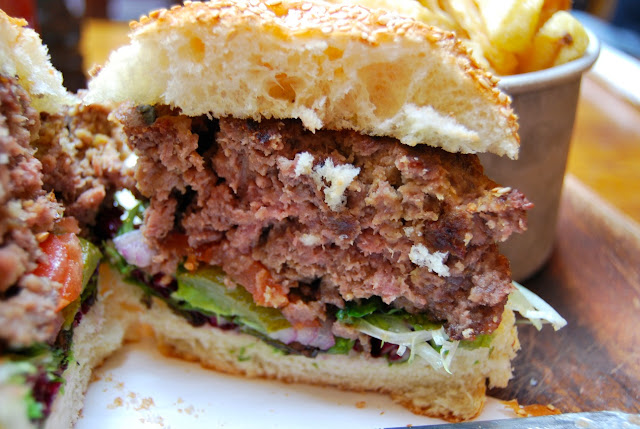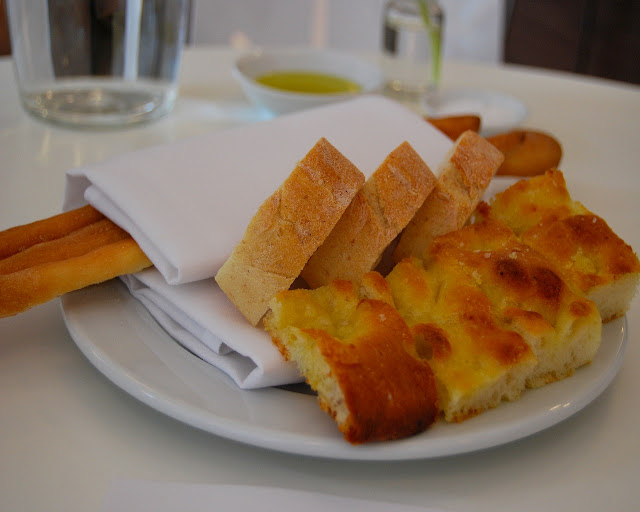My top three London burgers, as of 9th April, 2010, 1pm:
1. Goodman
2. Hawksmoor
3. Byron (best widely available)
My top three London burgers, as of 9th April, 2010, 1.05pm:
1. The Meatwagon
2. [SIGH]
3. [SIGH]
The London burger scene is definitely getting better. I even wrote an article saying as much on the quasi-biblical A Hamburger Today hamburger blog. Additionally, I often write about burgers on here (namely Byron and Goodman, as recent examples). The banner for this blog features an image of a great burger; I like hamburgers, and I've started liking them in London a lot more than I once did. A visit to the highly elusive Meatwagon on the hottest day of the year so far has blown all competition out of the water, far exceeding my expectations and delivering a truly fantastic burger. London's best, in fact, and at a price which makes a gruelling 90 minute journey to an industrial estate in Peckham well worth it.

Yianni Papoutsis. The half-Greek, half-Irish, carpenter/caterer with a desire to improve London's slowly blossoming street food scene. He knows about burgers, having travelled around the US of A on a search for brilliant food at low prices, in curbside locations, sampling some of America's best hamburgers en route. He cites the trucks in Los Angeles and San Francisco in particular, as big sources of inspiration. He pitches up with The Meatwagon whenever he has time off his day job, and plans to open more regularly in the longer days of summer. Here he is pictured with a six or seven ounce wad of chuck (just less than 20% fat; more on that later) just about to go on the grill. Also, note the Casio F91W on his left wrist, a classic watch (also worn by Sam of Mooli's).

The cooking process. Yianni places a ball of meat on the 30-year-old cast iron flat-top griddle and then squashes it down into a round patty with the palm of his hand. When asked how hot the griddle was exactly, he smiles and says "fucking hot." Good answer: the extreme heat of the cooking surface produces a crust that only griddle cooking can, skipping the charcoal-grilled taste for a superior crunch to the outside of the patty. The griddle can hold up to four burgers at a time, and all burgers are cooked "with a little bit of pink in the middle", though requests can be made for rare or otherwise. On the blend, Yianni bypasses the usual ratio of 80:20 in his freshly ground, locally purchased 28-day aged chuck in favour of a slightly leaner blend. He cites the reason that a fattier patty of minced beef will retain slightly unpleasant globules of uncooked fat if done rare, whilst his blend guarantees juiciness and a good eating experience no matter how it is cooked. Liberally seasoned with just salt and pepper after being squashed, Yianni flips the patties and then adds two slices of American cheese. Not Kraft Singles, but better, and he isn't letting anyone on to his cheesy secret weapon.

Steaming the cheese into the patty with a lid. A lid! I bloody love lids, I really do. No one else seems to do this in London, but it is an essential component to creating an environment where the cheese can steam and properly melt into the meat.
The cheese in all its melted glory.
The buns. A truly contentious issue with all burgers in London. A bit of meat this good needs a good bun, and Yianni has sourced the best burger bun available in London (well, for this type of burger, at least). A brioche bun would be absolutely wrong here. The bun is a soft sourdough, toasted and then placed on the meat for the final few seconds of the cooking process. A pleasure to eat, not distracting from the meat but complementing it and retaining its structure until the last bite. Hardly a surprise that Yianni and the local baker he sources the buns from took about three months to perfect the recipe.

Ready for the rabbit food, gherkins and the sauces. You can ask for your burger without any of the toppings if you wish, but a cheeseburger with 'the works' comes with shredded iceberg lettuce, dainty rings of red onion, French's American mustard and Heinz ketchup. You need to make sure to ask for gherkins, as some strange people don't like them. Another plus point: no watery April tomatoes. Brilliant.
The finished article, before being placed in some paper. If you want your burger for later, they'll wrap it in foil for you, otherwise a bit of paper and you're ready to go.
(Photo by me)
Cheeseburger (£5). Glorious, absolutely something else. The well-seasoned cast iron griddle gives the meat a good crunch, and the quality of the meat shines through. Slightly nutty and impossibly juicy meat enveloped by creamy and well-melted cheese, whilst the mustard and ketchup do not detract from the ground chuck whatsoever, instead adding welcome fruity and sweet notes. The onions and lettuce are crunchy and fresh, completing a delicious package. Note: the bun does look slightly too big for the meat in this picture, but it is perfectly proportioned. Each bite includes a bit of each component, all working wonderfully in synch.
Autopsy shot. Perhaps more well done than I would have liked, but even at medium-well it was still juicy and I had to dance like Michael Flatley to avoid the juices dripping all over my Air Force 1s. Seriously though, look at that goopy cheese. Amazing.
Not pictured: 'Bobcat Burger' (£6). So called after The Bobcat Bite in New Mexico, which has a Green Chile Cheeseburger on their menu. Like a regular cheeseburger, except some freshly sliced green chilli peppers which are fried in butter are placed on top. Seriously good, with the flavours of the chilli overcoming the initial heat kick.

Philly cheesesteak (£6). Yianni, despite being a dab hand at making cheeseburgers, also dabbles in other American favourites such as cheesesteaks, tacos and even Korean Fried Chicken! The cheesesteak here has a few points that would probably make a South Philadelphian shake their fist angrily. First of all, the bread: rather than a soft, sub type Italian roll, Yianni a chewy and soft baguette. The cheese: no Cheez Whiz here, instead more of that high quality American cheese, nicely melted with the meat. Speaking of meat, Yianni uses seriously good rump, from the same butcher he sources the chuck for the burgers, and slices it thinly from a large piece just before throwing them on to the griddle. They get a nice seared crust, whilst the middle of each sizeable slice is tender and juicy. The griddled peppers and onions add a welcome crunch and acidic sweetness to every mouthful. Insanely, this is only £1 more dear than the predictably poor effort from Subway.
The Meatwagon is probably the most exciting thing on the London food scene for me right now. Perhaps one thing that can be said about this operation, though, is that the elusive nature of Yianni's burgers aids the burger experience; the thrill of the chase, following him on Twitter and awaiting an announcement of an appearance, then going to an industrial estate in Peckham - they are all part of the Whole Burger Experience. Would a bricks and mortar Meatwagon be less exciting and would people be less inclined to trek there? Perhaps, but the proof is in the eating, and Yianni's burgers are the best around.
























































